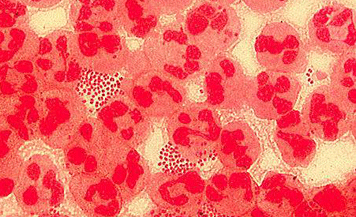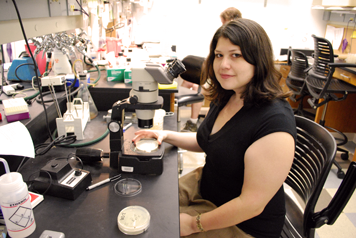Professor, Student Identify Alternative DNA Structure for Shape-Shifting Pathogen
 |
|
Light micrograph of Neisseria gonorrhoeae and white cells from a person with gonorrhea |
August 21, 2009 â Researchers at the Feinberg School of Medicine have identified an alternative DNA structure existing within the bacterium Neisseria gonorrhoeae that enables the pathogen to change its shape to avoid detection by the immune system. The research, conducted by Dr. Hank Seifert, professor of microbiology-immunology, and graduate student Laty Cahoon, appeared in the August 7, 2009 issue of the journal Science.
N. gonorrhoeae is the causative agent of the sexually transmitted disease gonorrhea and has served as the basis for Seifert’s investigative research for 25 years. No documented natural immunity to gonococcal infection, which occurs solely in humans, exists. This is partly due to the enormous potential N. gonorrhoeae has for antigenic variation of surface proteins.
“Gonorrhea is a significant health problem in the U.S. and throughout the world,” Seifert said. “About 360,000 cases were reported in 2006, and we estimate at least twice that number is infected each year.”
Seifert’s goal is to discover new mechanisms important for the continued existence of this microbe in the human population to further the team’s understanding of how infectious agents have evolved genetically.
“Gonorrhea affects 16 to 24 year olds, with no immune dysfunction. This age group is arguably the healthiest on the planet,” Seifert said. Further understanding of the mechanisms used by N. gonorrhoeae to outsmart the immune system could have implications for future infectious disease research and prevention.
 |
|
Laty Cahoon, a Ph.D. candidate in the Integrated Graduate Program in Life Sciences (IGP) published her findings in Science. |
The publication of these findings is an achievement for Cahoon, 29, a Ph.D. candidate in the Integrated Graduate Program in Life Sciences (IGP) who led the research alongside Seifert.
“I’m incredibly lucky to have Dr. Seifert as my mentor,” said Cahoon, who also credits her supportive network of family and friends for her success. “This was a significant amount of work, and it’s humbling to be acknowledged.”
Cahoon, whose career goal is to become a professor, hopes her work will inspire other minority students to become involved with the sciences. She currently a member of SACNAS, a society of scientists dedicated to fostering the success of Hispanic/Chicano and Native American scientists, as well as Northwestern University’s AGEP program to increase the number of underrepresented minorities in science.
In addition to Cahoon, Seifert’s laboratory team includes research faculty, post-doctoral fellows and graduate students.
“Laty should be very proud; this is an amazing amount of work for one person to have produced,” concluded Seifert. “It’s really a tour de force of research.”
To read the full study, visit Science: http://www.sciencemag.org/cgi/content/full/325/5941/764.
To learn more about Seifert’s research, visit: http://bugs.mimnet.northwestern.edu/labs/Faculty/seiferth.html.






